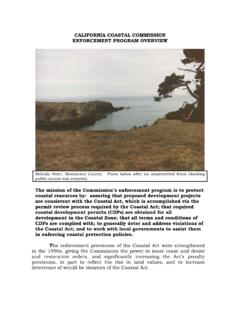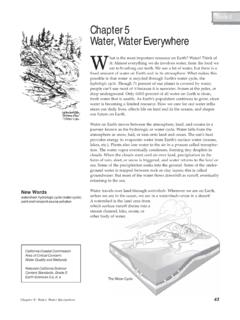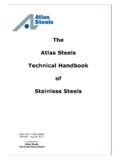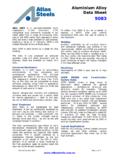Transcription of Biodiversity Atlas Climate and Topography - California
1 12 Atlas of the Biodiversity of CaliforniaA Remarkable GeographyClimate and TopographyBy Eric KauffmanCalifornia is one of the few places where five majorclimate types occur in close proximity. Here, theDesert, Cool Interior, Highland, and Steppe climatesborder a smaller region of Mediterranean the only other place like California is centralChile, where this convergence is made even moreextreme by the dramatic Andean climates go, the Mediterranean Climate is of the Mediterranean Sea region, it is limitedto five locations: two in Australia, one in South Africa,one in Chile, and one in California , the Mediterranean Climate has threevariations. One is the cool summer/cool winterclimate found along the coast and the western slope ofthe Sierra Nevada. A second variation, also along thecoast, is similar but has frequent summer fog.
2 Thethird is an interior valley version with hotter summersand cooler winters. With all types, most of theprecipitation falls in winter not summer which isunusual for much of the world, where the opposite mild temperatures and winter rain of theMediterranean Climate support some of the highestspecies richness in the state. Interestingly, however, California s Desert climates rival the Mediterraneanfor plant and animal species richness. For California sdeserts, Topography comes into play along withclimate. The Mojave Region is characterized bysweeping valleys and rugged, high elevation mountainranges. In general, upper elevations catch more rainand snow, and are much cooler than the valleys is this more apparent than in the contrastbetween Death Valley, which is below sea level, andthe Panamint Range, with peaks as high as 10,000 feetabove sea level.
3 In Death Valley, plants and animalsmay bake in 115 degree summer heat while 12 milesaway and 2 miles up, cool breezes blow through thedark green needles of bristlecone pine (Pinus longaeva)and the delicate leaves of mountain maple (Acerglabrum). California s higher elevations, such as those found inthe Modoc and Sierra regions, generally have twomajor Climate types: a Cool Interior Climate and aHighland Climate . In these areas, the conditions thatdetermine most other climates (latitude, prevailingwinds, and temperature) are strongly modified byelevation, slope, and aspect. Aspect, or the direction aslope faces, is very important. South facing slopescatch the sun s rays and heat, making them warmerand drier, while shaded north facing slopes are coolerand wetter. West facing slopes tend to catch moreprecipitation from storms moving inland from thePacific Ocean.
4 The result is vegetation diversity evenon a single mountain. For example, a ridge may haveoaks and open grass areas on one side and a densecanopy of fir or pine trees on the s Steppe Climate of the San Joaquin ValleyRegion is hot like a desert, but averages enoughmoisture to support grasslands and other vegetationnot commonly found in the desert. Julie Evens, Marc Hoshovsky,DFG photos: Todd Keeler-WolfVertical exaggeration: 36x13 Atlas of the Biodiversity of CaliforniaCalifornia Department of Fish and Game14,50010,0008,0006,0004,0002,0001,00 05001000-275 (below sea level)Elevation (Feet) CDFGS ource:National Elevation DatasetUnited States Geological Survey (1999)Topography14 Atlas of the Biodiversity of CaliforniaA Remarkable GeographyClimographs for Selected Climate Stations(See map on opposite page.)
5 Average Monthly Precipitation (inches)Average Monthly Temperature (degrees Fahrenheit)Average AnnualPrecipitation(Inches)Average High Temperatureof the Warmest Month(Degrees Fahrenheit)Average Low Temperatureof the Coldest Month(Degrees Fahrenheit)Sources: California Average Monthly and Annual PrecipitationCalifornia Average Monthly and Annual TemperatureThe Climate Source (1998a and b)Weather Observation Station RecordsNational Climatic Data Center (2002)15 Atlas of the Biodiversity of CaliforniaCalifornia Department of Fish and Game CDFGC limateModified K ppen Climate Classification System(BSh) Semi-arid, steppe (hot)(BSk) Semi-arid, steppe(BSkn) Semi-arid, steppe w/summer fog(BWh) Arid low latitude desert (hot)(BWk) Arid mid latitude desert(Csa) Mediterranean/hot summer(Csb) Mediterranean/cool summer(Csbn) Mediterranean/summer fog(Dsb) Cool continental/dry summer(Dsc) Cold winter/dry summer(H) Highland/TimberlineSources.
6 California Climate Based on the K ppen Classification SystemCalifornia Department of Fish and Game (2002a)The K ppen System used here is taken from Critchfield (1983).Note:The locations of the Climate stations graphedon the opposite page are shown in bold type onthis map.














